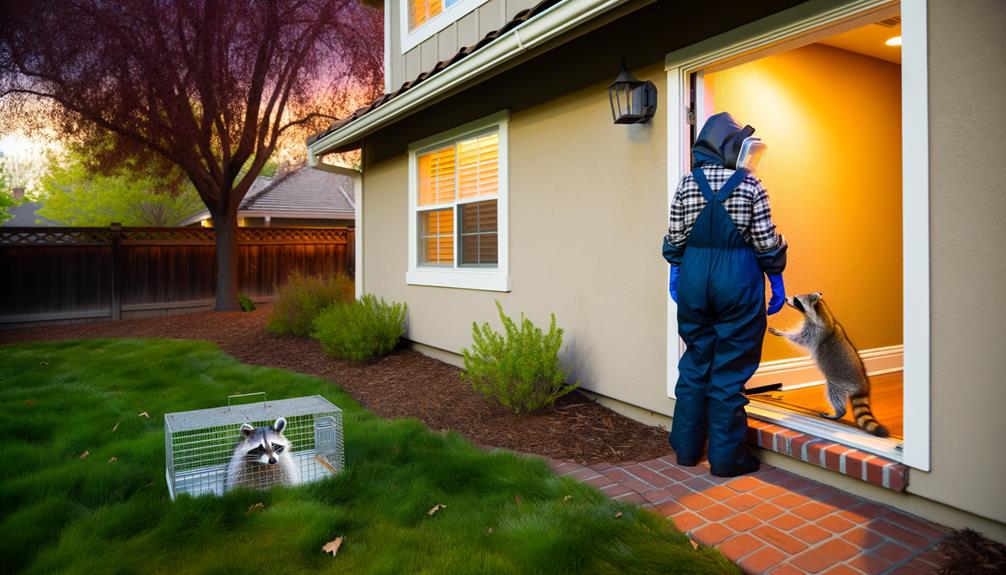How Do You Get Rid of Raccoons in Your House?
To get rid of raccoons in your house, start by identifying signs like unusual noises, droppings, and disturbed trash. Inspect areas such as attics and crawl spaces for evidence.
Secure all entry points using metal mesh and seal gaps with caulking or steel wool. Employ humane traps with appropriate bait and check them frequently.
Apply deterrents like motion-activated lights and natural repellents. Wear gloves and follow safety protocols to prevent exposure to pathogens.
If the problem persists, contact professional wildlife control experts for thorough removal and prevention. For more detailed steps and safety measures, continue exploring.

Key Takeaways
- Secure all entry points with metal mesh, caps, or caulking to prevent raccoon access.
- Use humane live traps baited with appealing foods like tuna or marshmallows.
- Install motion-activated lights and ultrasonic devices as deterrents near potential entry points.
- Inspect attics, basements, and crawl spaces for signs of raccoon activity and remove any droppings.
- Consider hiring professional wildlife control experts for safe and thorough raccoon removal.
Identifying Raccoon Infestation
To accurately identify a raccoon infestation in your home, begin by looking for telltale signs such as unusual noises in the attic, droppings, and disturbed trash. Nocturnal sounds like scratching or thumping can indicate raccoons.
Inspect attics, basements, and crawl spaces for droppings that resemble small dog feces. Additionally, examine trash cans or compost bins for signs of tampering. Wear gloves and a mask when handling potential raccoon droppings to avoid zoonotic diseases.
Check for paw prints around entry points and greasy smudge marks, which indicate frequent raccoon traffic. Utilizing a motion-activated camera can further confirm their presence.
Prompt identification is essential to address the issue effectively and responsibly, ensuring the safety of both residents and the animals.
Securing Entry Points
Securing entry points is vital to preventing raccoons from gaining access to your home and causing further damage. Begin by conducting a thorough inspection of your property to identify potential entry points.
Focus on:
- Roof and Chimney: Make sure that vents, chimneys, and roof edges are securely covered with metal mesh or caps.
- Attic and Eaves: Mend any broken or loose boards, and seal gaps with durable materials.
- Ground Level: Check for openings around foundations, doors, and windows; seal them with steel wool or caulking.
Safety protocols are important. Always wear gloves and a mask when handling materials to avoid exposure to harmful pathogens.
Humane Trapping Methods
Employing humane trapping methods is essential for safely capturing raccoons without causing them harm. Start by selecting a live trap that is appropriately sized for raccoons, ensuring it is sturdy and has a sensitive trigger mechanism.
Bait the trap using foods raccoons are attracted to, such as canned tuna or marshmallows, and place it in an area where raccoons are frequently seen. Check the trap regularly, ideally every few hours, to minimize stress for the animal. Always wear gloves to prevent transferring human scent and potential bites.
Once captured, cover the trap with a cloth to calm the raccoon, and relocate it at least 10 miles away from your home, following local wildlife regulations.
Using Deterrents
Utilizing a variety of deterrents can effectively discourage raccoons from entering your home and surrounding property. Implementing these measures guarantees a safer environment for both you and the animals.
- Install Motion-Activated Lights:
Bright lights can startle raccoons and deter them from approaching your house. Make sure lights are positioned to cover entry points.
- Utilize Ultrasonic Devices:
These emit high-frequency sounds that are unpleasant to raccoons but inaudible to humans. Place them near suspected entry points.
- Apply Natural Repellents:
Substances like ammonia, vinegar, and predator urine can be effective. Soak rags in these and place them strategically around your property.
When using deterrents, always follow safety protocols, such as wearing gloves and making certain devices are out of reach of children.
Professional Help
When deterrents prove insufficient in resolving your raccoon issue, enlisting the services of a professional wildlife control expert becomes necessary for a thorough and safe removal process.
First, the expert will conduct a detailed inspection to identify entry points and potential nesting areas. They will then use humane trapping methods to capture the raccoons without causing harm.
After removal, the professional will implement exclusion techniques, such as sealing entry points, to prevent future infestations. Safety protocols, including the use of personal protective equipment and adherence to wildlife handling regulations, are strictly followed to guarantee the wellbeing of both the animals and the residents.
Additionally, professionals offer clean-up services to address any biohazards left by the raccoons.
Conclusion
To sum up, the sophisticated battle against raccoon invasions demands a multi-pronged strategy that any homeowner can implement with the skill of a seasoned strategist. Recognizing infestations, strengthening entry points, using humane traps, and employing deterrents, all while keeping the possibility of professional assistance on standby, guarantees a stronghold-like defense against these nighttime trespassers.
One could even argue raccoons have inadvertently become the supreme challenge of human cleverness in household protection and wildlife control.






